

Hsimed
HSI Medical is a leading provider of affordable, high quality medical devices to our partners for doctors, clinics, hospitals and healthcare agencies worldwide. For More Information:
What is Endotracheal Intubation? Chapter 1 — Updated Oct 07, 2021 — 19,031 characters Endotracheal intubation (EI) is a procedure that is used to treat people who are unable or unwilling to breathe.
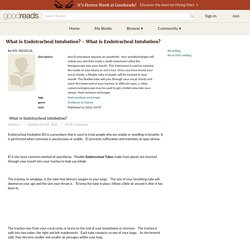
It is performed when someone is unconscious or unable. EI prevents suffocation and maintains an open airway. EI is the most common method of anesthesia. Flexible Endotracheal Tubes made from plastic are inserted through your mouth into your trachea to help you inhale. What You Need to Know About Anaesthesia and Breathing Systems? Breathing systems are designed for patients to receive oxygen and anaesthetic gases, as well as to remove carbon dioxide.
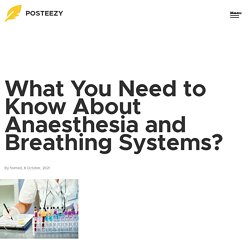
While all breathing systems share similar components, each system is configured differently. The common components are fresh gas flow, tubing to allow direct gas flow, and an adjustable pressure limit valve that regulates pressure and allows the storage and scavenging of waste gas. The reservoir bag stores gas and helps with ventilation. Each breathing system has three sources of gas: fresh gas and exhaled space gases. Circumcision Ring. Neonatal CPAP. Bag Valve Mask (BVM) - HSI Medical. Bag-Valve-Mask (BVM) devices, also known as Ambu bags, are self-inflating manual resuscitation systems.

In BVM ventilation, a self-inflating bag (resuscitator bag) is attached to a nonrebreathing valve and then to a face mask that conforms to the soft tissues of the face. The opposite end of the bag is attached to an oxygen source (100% oxygen) and usually a reservoir bag. The mask is manually held tightly against the face, and squeezing the bag ventilates the patient through the nose and mouth. Unless contraindicated, airway adjuncts such as nasopharyngeal and/or oropharyngeal airways are used during BVM ventilation to assist in creating a patent airway. What is HME And Its Types. When the structures of the upper airways are not being used during anaesthesia or intensive care, heat and moisture exchangers and breath system filters can be used to replace them.
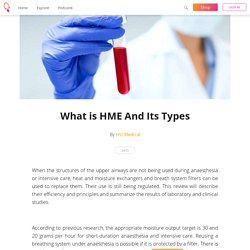
Their use is still being regulated. This review will describe their efficiency and principles and summarize the results of laboratory and clinical studies. According to previous research, the appropriate moisture output target is 30 and 20 grams per hour for short-duration anaesthesia and intensive care. Reusing a breathing system under anaesthesia is possible if it is protected by a filter. There is a wide range in gas-borne filter performance. contaminated condensate may pass through filters at typical pressures during mechanical ventilation. Steps to Use Closed Suctioning. Wash your hands in accordance with your unit protocol.

Wash your hands according your unit protocol. We recommend using facial protection and gloves while working with the device. Your unit protocol may require you to take additional protective measures. Know About Central Venous Catheter. How Endotracheal Tube is Used. Endotracheal tube is a flexible tube made of plastic that is passed through the mouth and into the windpipe to aid in breathing.
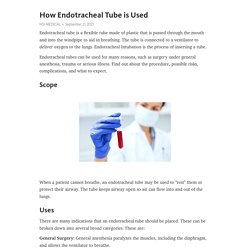
The tube is connected to a ventilator to deliver oxygen to the lungs. Endotracheal Intubation is the process of inserting a tube. Endotracheal tubes can be used for many reasons, such as surgery under general anesthesia, trauma or serious illness. Find out about the procedure, possible risks, complications, and what to expect. The plestibellum is present. Suction system with closed suction. A Plestibellum. Continuous Positive Airway Pressure and Pre-mature Babies. Benefits of Using Heat and Moisture Exchange Filters. Heat and Moisture Exchange (HME) filters help facilitate the normal cooling, humidification and filtering functions of an individual's upper respiratory system while he is undergoing surgery or in intensive care.
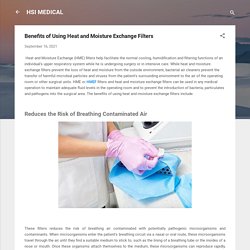
While heat and moisture exchange filters prevent the loss of heat and moisture from the outside environment, bacterial air cleaners prevent the transfer of harmful microbial particles and viruses from the patient's surrounding environment to the air of the operating room or other surgical units. HME or HMEF filters and heat and moisture exchange filters can be used in any medical operation to maintain adequate fluid levels in the operating room and to prevent the introduction of bacteria, particulates and pathogens into the surgical area. The benefits of using heat and moisture exchange filters include: All About Anaesthesia andBreathing Systems. Breathing systems are designed to provide oxygen and anaesthetic gas to patients, and to eliminate carbon dioxide.

Although all breathing systems have similar components, they are each configured in a different way. Common components include fresh gas flow, tubing for direct gas flow and an adjustable pressure limit valve to regulate pressure and allow the scavenging and storage of waste gas. Intubation of the endotracheal tube. A CPAP for neonates. What are the purposes of heat moisture exchangers and laryngeal masks? What Are The Benefits Of CPAP In Neonatals? - HSI Medical. Neonatal Continuous Positive Airway Pressure, also known as CPAP, is a breathing aid for premature babies who cannot breathe on their own during the first few months of life. nCPAP is also an acronym for "Neonatal Continuous positive airway pressure".
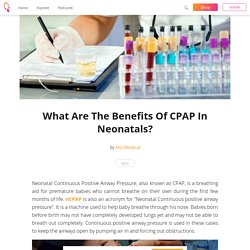
It is a machine used to help baby breathe through his nose. Babies born before birth may not have completely developed lungs yet and may not be able to breath out completely. Continuous positive airway pressure is used in these cases to keep the airways open by pumping air in and forcing out obstructions. A large proportion of all neonates in the developing world suffer from respiratory complications in some way or another. Steps Involved in Closed Suctioning. Install the tube connecting the tube and the suction to the negative pressure manometer and collection jar.
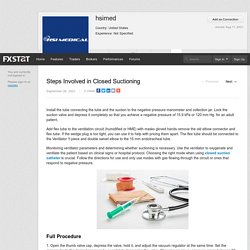
Lock the suction valve and depress it completely so that you achieve a negative pressure of 15.9 kPa or 120 mm Hg. for an adult patient, Add flex tube to the ventilation circuit (humidified or HME) with masks gloved hands remove the old elbow connector and flex tube. If the wedge plug is too tight, you can use it to help with pricing them apart. The neonatal CPAP. Effects of Obstructive Sleep Apnea in Neonates. Neonatal CPAP stands for Continuous Positive Airway Pressure. NCPAP , also an acronym for constant positive airway pressure, is an alternative form of treatment used to help prevent sleep apnea in infants and small children. CPAP is actually a medical device which makes use of pressurized air while patients sleep to keep them breathing normally at night. The continuous flow of pressurized air ensures that patients breathe in a consistent manner throughout the night and reduces occurrences of apnea.
How Do Central Venous Catheters Work? How do central venous catheters work? " This is an often asked question that has not been answered. If one does not know what a catheter is, he or she may quickly become confused and wonder why this procedure is necessary. Known as venous stasis, this occurs when veins become thickened and blocked. anesthesia breathing circuits are used in treating conditions that are considered to be very close to the heart by delivering large amounts of medicine and or elements through them.
Catheters are thin, tube-shaped medical devices with an opening at one end and a pump at the other. Through the catheter hole, the device is inserted into one of the veins in the leg and forces the fluid or solution through the opening into the body of the patient. Laryngeal Mask. A laryngeal sac, also called larynx or laryngopahy, is an anatomical structure that includes the uvula, the voice box and the soft palate. Attached to the back end of the throat is the larynx. It has two major branches that are separated by numerous smaller branches. They are connected to their backs by the vocal cords.
Because the larynx plays a crucial role in sound production, it is also important for speech. The Role Of Laryngeal Mask In Surgery. To deliver anesthesia, a long tube called a ventilator is placed through the LMA and anesthesia breathing circuits are also provided. The ventilator makes sure that adequate ventilation is present even when there is no oxygen present in the patient's blood.This ventilator can be switched off if there is sufficient oxygen in the blood. In low-breathing-rate patients, a ventilator can be switched off so that there is no additional time or effort spent while waiting for a bag of fluid to be inhaled before the tube is inserted through the laryngeal mask.When a patient is having anesthesia, they may not be able to breathe through their mouth or nose.
Neonates can benefit from CPAP. What Are The Benefits Of CPAP For Neonatals? Neonatal Continuous Positive Airway Pressure, also known as CPAP, is a breathing aid for premature babies who cannot breathe on their own during the first few months of life. nCPAP is also an acronym for "Neonatal Continuous positive airway pressure". It is a machine used to help baby breathe through his nose. Babies born before birth may not have completely developed lungs yet and may not be able to breath out completely. Continuous positive airway pressure is used in these cases to keep the airways open by pumping air in and forcing out obstructions. Neonatal circumcision rings are beneficial.
Learn the Types of Closed Suction Catheters. Where does Mapleson Circuits fit into this picture. Buy Bag Valve, Laryngeal Masks Online - HSI Medical. Bag valve mask. A Brief Review Of The AMBU Rechargeable Rescuer Bag Valve Mask. Use a Neonatal Continuous Positive Away Pressure Device for Infants to Get the Best Results. A brief review of the AMBU Rechargeable rescuer bag valve mask. CPAP Is Beneficial For Neonatals? Plastibell Machines: A Brief History. What's A Central Venous Catheter Useful For? The Benefits of using a Neonatal Continuous Positive Airway Pressure for Infants. The AMBU Bag and Its Use. What Is the Importance of Medically Proven Technologies?
What is Plastibell. Introduction of Heating and moisture exchanger. The anesthesia breathing circuit. An explanation of the use of suction toothbrushes. The prefilled humidifier. What You Should Know About Needle Biopsy. A Brief Review of the AMBU Rechargeable Rescuer Bag Valve Mask. The Latest Trends in Anesthesia Breathing Circuits. Endotracheal Tubes – Benefits and Uses. Ring for circumcision. Buy Central Venous Catheter (CVC) Kit - HSI Medical. Medical Grade Mapleson Circuits for Breathing Aide - HSI Medical. Heat moisture exchanger.
A Brief History of Plastibell Machines. Laryngeal Mask. Heat moisture exchanger. What Is a Suction Toothbrush And its Advantages. Hsi-med.